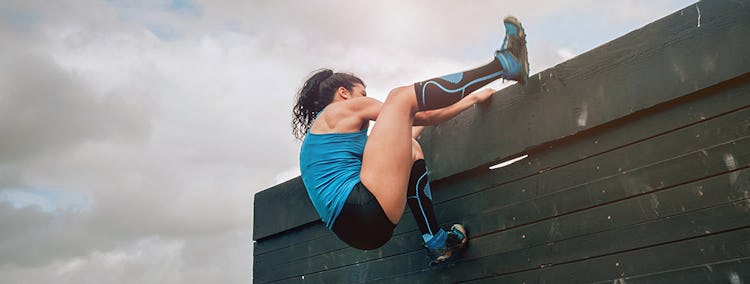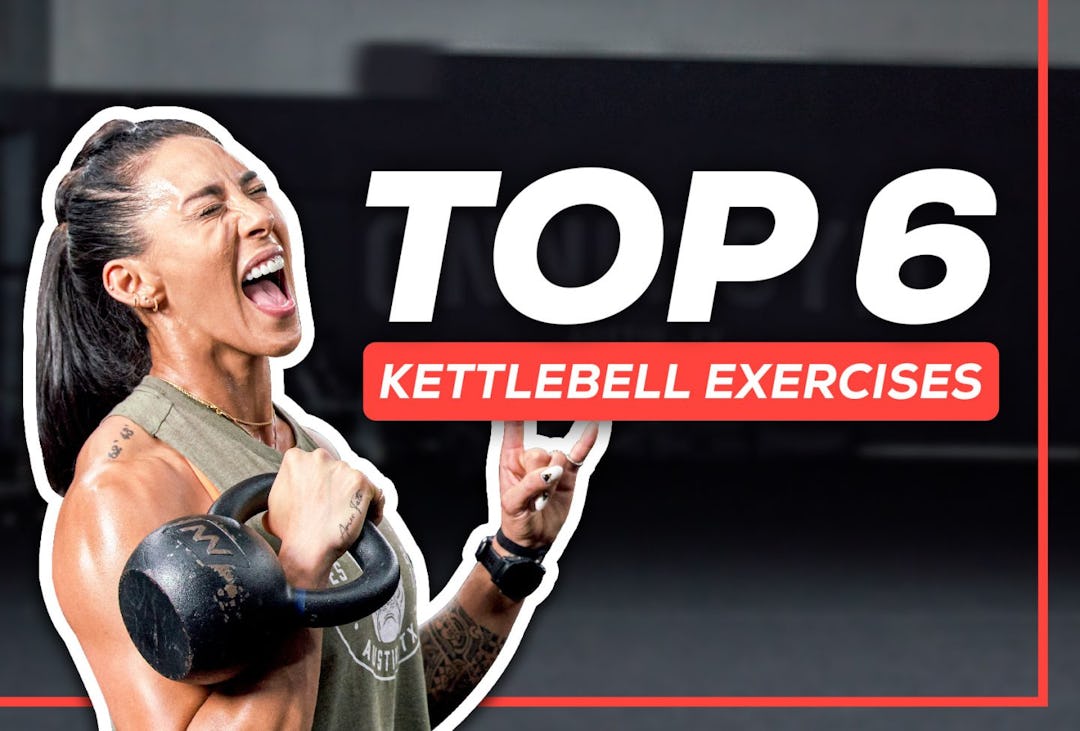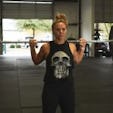OK, you’re convinced that kettlebells are cool—and worthwhile training tools—and you’re ready to try them¦ Now where do you begin? We asked fitness influencer Hannah Eden (HannahEdenFitness.com, and @hannaheden_fitness on Instagram) to select what she considers the best movements for those new to kettlebells, and she came up with these six—simple exercises guaranteed to help you build muscle, get lean, and master the mechanics that allow you to perform more advanced kettlebell training in the not too distant future. You can do them all at home with a single kettlebell!
See the video below for Eden’s explanation of each exercise, along with a demonstration, and read on for more pointers and tips.
Top 6 Kettlebell Exercises For Beginners
1. Single-Kettlebell Deadlift
(See 00:10 in the video above)
The deadlift is a timeless exercise that can be done with a variety of equipment, but the core movement is always the same: you have to bend at the hips while keeping your back straight. Eden explains that the deadlift mimics the hip hinge and extension mechanics we all use daily to pick things up from the floor and stand up from a chair. If you’re an athlete, it’s essential for explosive movements like jumping and running, and if you want to build a strong and shapely butt and legs, the deadlift will cover that as well.
“It’s not the same as a squat,” cautions Eden, who notes that many people tend to bend their knees too much when they should be bending their hips more.
Step 1. Place a kettlebell on the floor and stand with your feet between hip and shoulder-width. The kettlebell should be between your big toes. Unlock your knees so there’s a soft bend in them.
Step 2. Bend your hips backward as if trying to touch them to a wall behind you. Imagine you have a broomstick on the back of your spine and you’re trying to keep it balanced and touching your back, the back of your head, and your butt all at the same time—your back has to move along with your hips at the same time to keep the stick in position. That means no rounding your spine.
When your hips are pushed back as far as they can go, stop. “Don’t continue bending forward with your chest, or you’ll lose your lower back position,” says Eden. You’ll feel a stretch on your glutes and hamstrings. If you can reach the kettlebell handle from here, grasp it with both hands. (If not, we’ll explain what to do below).
Step 3. Drive your shoulders back and down and brace your core. Push through your heels and squeeze your glutes to stand tall, lifting the kettlebell off the floor. That’s one rep.
Bend your hips back in the same way you did to begin the exercise to return the weight to the floor.
If you can’t reach the kettlebell handle when you hinge your hips, start the exercise from the top position—standing with the kettlebell held in front of you at arm’s length. “Put your shoulders in your back pockets,” says Eden, and “hold your chest up nice and tall.” Now bend your hips back (with soft knees) and lower the weight as close as you can to the floor without losing your lower back position. Keep the kettlebell pulled in close to your body as you descend. From there, extend your hips to stand tall again.
2. Single-Kettlebell Squat
(See 03:08 in the video)
The squat is a foundational movement pattern that really lights up the thigh muscles. “We sit down and stand up every day,” says Eden. “If you have strong legs, you’ll be able to move through life a little easier.” Squatting with one kettlebell is also called a goblet squat, and here’s how Eden suggests you do it.
Step 1. Hold the kettlebell by the horns and stand with feet hip to shoulder-width apart. Draw your shoulders back and down, and tuck your arms in.
Step 2. Take a deep breath in. Bend your hips while you bend your knees, and squat with your torso as upright as possible. “Imagine there’s a chair behind you,” says Eden, and try to sit back into it. Drive your knees apart to make room for your squat—this will allow to stay more upright and squat deeper. Go as low as you can without your pelvis tucking under. If you feel your tailbone tuck, that’s too far.
Step 3. Once you’ve tapped your butt on the seat of the imaginary chair, drive through your heels and squeeze your glutes to stand back upright. Breathe out as you come up.
Again, this is not the same movement as the deadlift. Your hips bend backward, but your knees should bend fully, and while you keep your torso straight in both movements, you’ll keep it as vertical as possible in the goblet squat.
“A common mistake is letting your knees cave in,” says Eden. If that happens, “corkscrew your feet into the floor.” That is, twist them down to create tension in your hips. You should feel the arches in your feet rise and your hip muscles tense. This will help your knees stay in line with your big toes as you squat.
“Another mistake is butt wink,” says Eden, which is when the pelvis tucks under and your lower back rounds. This is a dangerous habit to get into, especially when working with heavier weight, as it can put pressure on the discs in the lower back. Stop your range of motion short of where your pelvis tucks.
Lastly, don’t bounce out of “the hole.” Going as low as you can may cause a stretch reflex that helps you power up from the bottom position, but that’s not the muscles working. It’s also dangerous for your lower back. Eden recommends going only as low as you can control with good form. As you get stronger and more mobile, you’ll be able to squat deeper.
3. Single-Kettlebell Hinge
(See 05:37 in the video)
If you have trouble with the deadlift, or any of its variants, the kettlebell hinge (also known as a chest swing) is a good movement to practice. It teaches you to hinge at the hips with a very safe movement that’s easy to master, and it works the glutes and hamstrings hard at the same time. The chest swing will also prepare you for more dynamic kettlebell movements, like the standard swing done between the legs, as well as snatches and cleans. “In my opinion, you should do the hinge before you go for the full kettlebell swing,” says Eden.
Step 1. Stand with feet between hip and shoulder width, and hold the kettlebell by its horns, pulling the bottom of the bell into your lower sternum. Draw your shoulder blades together and down (“proud chest”), and cast your eyes on a spot on the floor approximately 15 feet in front of you. Take a deep breath into your belly, and brace your core.
Step 2. Tilt your tailbone upward slightly (so your pelvis tips forward a bit). Keeping a long spine, bend your hips straight back, as if you were trying to touch your butt to the wall behind you. Allow your knees to bend as needed.
Step 3. When you feel a stretch in your hamstrings, exhale, and extend your hips and squeeze your glutes, tucking your tailbone under as you lock out your hips.

4. Single-Kettlebell Swing
(See 06:50 in the video)
The classic kettlebell swing builds explosiveness that’s crucial for athletes, and, when done for high reps, can be a great protocol for endurance. That said, it can be dangerous if you’re not careful. Make sure you’ve mastered the hinge/chest swing above before you take this one on, and when you’re ready, Eden suggests elevating the kettlebell on a block first.
“You need the mobility to keep your lower back in a safe position when you pull the kettlebell off the floor for the swing,” says Eden. If you’re new to kettlebell swings, as well as these other movements, you may not have that mobility and body control yet, so there’s nothing wrong with shortening the range of motion a bit until you get there.
Place the kettlebell on a yoga block or mat to raise it a few inches from the floor. This will lessen the risk of you rounding your lower back when you begin the swing.
Step 1. Stand with the kettlebell just in front of your feet, and place your feet slightly wider than shoulder width. Draw your elbows back so your shoulder blades pinch together. Soften your knees, and bend your hips (if it helps, you can chop your hands into the crease of your hips to cue you to move only from the hips and not the spine). Bend until you feel a deep stretch in your glutes and hamstrings and your fingers can barely reach the kettlebell handle. If you’re keeping the proud-chest position, your chest should still be visible from the front.
Step 2: The kettlebell handle should be directly under your eyes. Reach to grasp the handle and tilt it back toward you. Now think about tucking your shoulder blades into your back pockets, which will draw your shoulders down and prevent any shrugging. Try to bend the kettlebell handle in half, which you’ll feel activates your lats.
Step 3. Hike the kettlebell back as if it were a football, aiming for the triangular area formed by the space between your knees and your crotch. Think about pulling the weight back between your legs, not bending forward at the waist. When the weight hikes back, your forearms should lightly touch the inside of your thighs.
Step 4. As the weight swings back from between your legs, drive your feet into the floor and stand tall, locking out your knees. This will cause the kettlebell to swing up to shoulder level and prevent you from hyperextending your lower back (keep your core tight too, just in case). If you do it right, the kettlebell will feel weightless at the very top of the movement. As the weight swings back down, think about catching it and absorbing the momentum with your whole body by bending your hips to accommodate it. Then begin the next rep.
“The swing isn’t a pull with the arms,” says Eden. “It’s a push from the hips. The power comes from behind you.”
5. Single-Kettlebell Clean
(See 10:30 in the video)

Cleans are a full-body exercise and the gateway to doing all kinds of flashy, multidirectional movements with kettlebells. They set you up for flows—sequences of kettlebell exercises done seamlessly. But first, you have to learn to do one without smacking the weight into your wrist.
“Start by learning what I call the swing clean,” says Eden, which has similar mechanics to the swing/hinge movements we’ve already covered. The big difference is that, before, you swung the weight at arm’s length in front of you, and this time you’ll keep your elbow tucked close to your body. “The kettlebell will float,” says Eden, “and when it does, you’ll quickly spiral your wrist to get around and underneath it¦ Imagine you have a bowl at your belly button. Once you feel like your fist is at belly button height, scrape your palm around that bowl in a circular motion and then get your arm in tight.”
Swing Clean
Step 1. Set up as you did for the swing above, bending your hips back and grasping the kettlebell handle with one hand. Tighten your shoulders and tilt the handle back.
Step 2. Hike the weight back between your legs, and then extend your hips. When the weight reaches your belly button, spiral your wrist, drop your elbow, and pull the weight in tight to your side. If you do it right, the weight shouldn’t bang your arm. Your knuckles, wrist, and elbow should end up in one line.
When you’ve got that down, try what Eden calls the vertical clean, which is just another variation on the clean movement. In this case, the kettlebell starts right underneath you as opposed to in front. This clean has more in common with a squatting movement than a swing or hinge.
Vertical Clean
Step 1. Squat down and grasp the kettlebell. Your shoulders should be higher than your hips, so someone could read the logo on your T-shirt. If you’re cleaning with your left hand, turn your wrist (and the handle) so that your thumb points to the heel of your right foot. Starting with a little rotation helps encourage the spiral action needed for the clean.
Step 2. Drive through your heels to stand up straight. When you feel the weight reach your belly button, “scrape the bowl, and receive the bell,” says Eden. I.e., rotate your wrist and pull it to shoulder level. Clench your glutes and brace your core at the top.
6. Single-Kettlebell Press
(See 14:50 in the video)
Pressing a kettlebell overhead works your shoulders, arms, chest, and core, making it an awesome upper-body strengthener, but Eden cautions that you need the shoulder mobility to press the weight without losing a safe body position. “You have to be able to straighten your arms over your head while keeping your ribs tucked, core tight, and your spine straight,” she says. If you can’t do that, work on your mobility and use a regression of the press, such as the floor press, described in our Full-Body Kettlebell Workout For Beginners.
Step 1. Use the vertical clean described above to get the kettlebell into position. Your palm should face the opposite side of the room. Take a deep breath into your belly and brace your abs and glutes. Pull your ribs down and think “proud chest” and “long spine”.
Step 2. Press the weight overhead, allowing your arm to rotate so that your palm faces in front of you at the top of the lift. Note that your chin should be pulled back so that the weight has no trouble clearing it.
To lower the kettlebell, pull it back down into position—as if you were performing a pullup.
If the kettlebell you have is too heavy to press single-handed, you can do a two-handed press.
Two-Handed Press
Step 1. Hold the kettlebell by the horns with both hands at chest level. Tuck your elbows close to your sides. Brace your core and soften your knees.
Step 2. Press the weight overhead. You should finish with your biceps next to your ears.
Still another option is the push press, in which you use momentum from your legs to press the weight overhead. Push presses can be useful for training full-body power, as well as when you have a weight that’s too heavy to press strictly.
Push Press
Step 1. Set up as you did for the single-kettlebell press.
Step 2. Dip your knees quickly and use the resulting rebound to help you power the weight overhead. Keep your back straight and upright, as if sliding it down a wall and then back up again. Lower the weight to your shoulder again, bending your knees as you do so to help you absorb the force.

)





